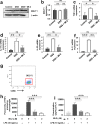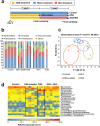Treatment of Dextran Sulfate Sodium-Induced Colitis with Mucosa-Associated Lymphoid Tissue Lymphoma Translocation 1 Inhibitor MI-2 Is Associated with Restoration of Gut Immune Function and the Microbiota
- PMID: 30249750
- PMCID: PMC6246915
- DOI: 10.1128/IAI.00091-18
Treatment of Dextran Sulfate Sodium-Induced Colitis with Mucosa-Associated Lymphoid Tissue Lymphoma Translocation 1 Inhibitor MI-2 Is Associated with Restoration of Gut Immune Function and the Microbiota
Abstract
Disruption of the healthy intestinal microbiome and homeostasis of the intestinal immune system, which are closely interactive, are two key factors for ulcerative colitis. Here, we show that MI-2, a selective inhibitor of mucosa-associated lymphoid tissue lymphoma translocation-1 (MALT1), alleviated excessive inflammatory responses and was associated with restoration of healthy intestinal microbiome in mice suffering from dextran sulfate sodium (DSS)-induced colitis. We found that the diversity of intestinal microbiome of mice with DSS-induced colitis was significantly lower than that of healthy mice. However, MI-2 treatment in mice with DSS-induced colitis resulted in restored microbially diverse populations. To understand the possibility of the beneficial effect of the restored microbially diverse populations of MI-2-treated mice with DSS-induced colitis, we showed that inserting fecal microbiota from MI-2-treated mice with DSS-induced colitis and healthy control mice into mice with DSS-induced colitis could alleviate symptoms of colitis. The possibility of MI-2 treatment in DSS-induced colitis, associated with restoration of healthy microbially diverse populations in addition to reshaping host immune modulating capacity by reducing inflammatory cytokines (tumor necrosis factor alpha, interleukin-1β [IL-1β], IL-17α, and IL-22), may be considered therapeutic for ulcerative colitis.
Keywords: MALT1; MI-2; inflammation; microbiome; ulcerative colitis.
Copyright © 2018 Lee et al.
Figures





Similar articles
-
Malt1 blocks IL-1β production by macrophages in vitro and limits dextran sodium sulfate-induced intestinal inflammation in vivo.J Leukoc Biol. 2018 Sep;104(3):557-572. doi: 10.1002/JLB.3VMA0118-019R. Epub 2018 Jun 14. J Leukoc Biol. 2018. PMID: 29901822
-
MALT1 inhibitors prevent the development of DSS-induced experimental colitis in mice via inhibiting NF-κB and NLRP3 inflammasome activation.Oncotarget. 2016 May 24;7(21):30536-49. doi: 10.18632/oncotarget.8867. Oncotarget. 2016. PMID: 27105502 Free PMC article.
-
Toll-Like Receptor 7 Agonist-Induced Dermatitis Causes Severe Dextran Sulfate Sodium Colitis by Altering the Gut Microbiome and Immune Cells.Cell Mol Gastroenterol Hepatol. 2018 Sep 25;7(1):135-156. doi: 10.1016/j.jcmgh.2018.09.010. eCollection 2019. Cell Mol Gastroenterol Hepatol. 2018. PMID: 30510995 Free PMC article.
-
Impact of Food Additives on Gut Homeostasis.Nutrients. 2019 Oct 1;11(10):2334. doi: 10.3390/nu11102334. Nutrients. 2019. PMID: 31581570 Free PMC article.
-
Changes in serum inflammatory cytokine levels and intestinal flora in a self-healing dextran sodium sulfate-induced ulcerative colitis murine model.Life Sci. 2020 Dec 15;263:118587. doi: 10.1016/j.lfs.2020.118587. Epub 2020 Oct 13. Life Sci. 2020. PMID: 33065145 Review.
Cited by
-
Improvement of antioxidant capability by dietary N-acetyl cysteine supplementation alleviates bone loss induced by chronic heat stress in finisher broilers.J Anim Sci Biotechnol. 2024 Dec 1;15(1):158. doi: 10.1186/s40104-024-01114-4. J Anim Sci Biotechnol. 2024. PMID: 39616350 Free PMC article.
-
IgA Determines Bacterial Composition in the Gut.Crohns Colitis 360. 2023 May 26;5(3):otad030. doi: 10.1093/crocol/otad030. eCollection 2023 Jul. Crohns Colitis 360. 2023. PMID: 37288325 Free PMC article.
-
Malt1 Protease Deficiency in Mice Disrupts Immune Homeostasis at Environmental Barriers and Drives Systemic T Cell-Mediated Autoimmunity.J Immunol. 2019 Dec 1;203(11):2791-2806. doi: 10.4049/jimmunol.1900327. Epub 2019 Oct 28. J Immunol. 2019. PMID: 31659015 Free PMC article.
-
Physical Activity Shapes the Intestinal Microbiome and Immunity of Healthy Mice but Has No Protective Effects against Colitis in MUC2-/- Mice.mSystems. 2020 Oct 6;5(5):e00515-20. doi: 10.1128/mSystems.00515-20. mSystems. 2020. PMID: 33024049 Free PMC article.
-
Colon impairments and inflammation driven by an altered gut microbiota leads to social behavior deficits rescued by hyaluronic acid and celecoxib.BMC Med. 2024 Apr 29;22(1):182. doi: 10.1186/s12916-024-03323-0. BMC Med. 2024. PMID: 38685001 Free PMC article.
References
-
- Triantafillidis JK, Nasioulas G, Kosmidis PA. 2009. Colorectal cancer and inflammatory bowel disease: epidemiology, risk factors, mechanisms of carcinogenesis and prevention strategies. Anticancer Res 29:2727–2737. - PubMed
-
- Bajer L, Kverka M, Kostovcik M, Macinga P, Dvorak J, Stehlikova Z, Brezina J, Wohl P, Spicak J, Drastich P. 2017. Distinct gut microbiota profiles in patients with primary sclerosing cholangitis and ulcerative colitis. World J Gastroenterol 23:4548–4558. doi:10.3748/wjg.v23.i25.4548. - DOI - PMC - PubMed
Publication types
MeSH terms
Substances
LinkOut - more resources
Full Text Sources
Other Literature Sources

